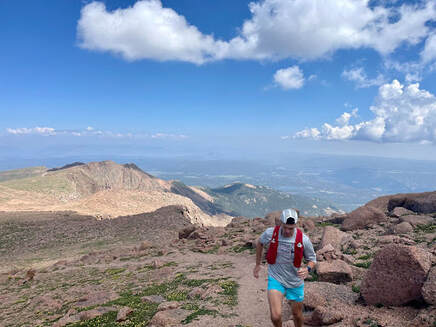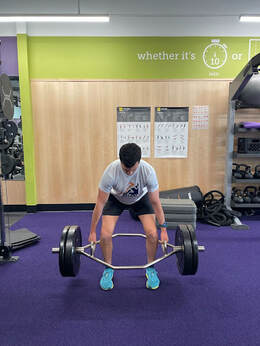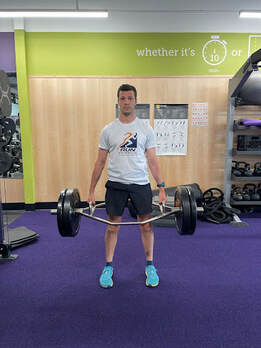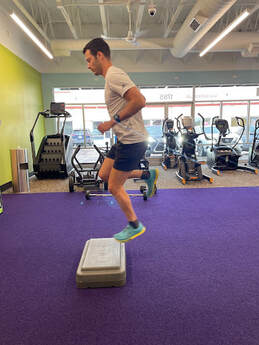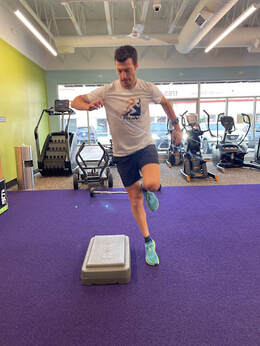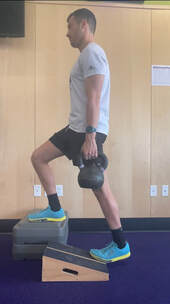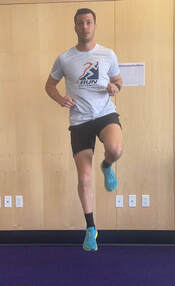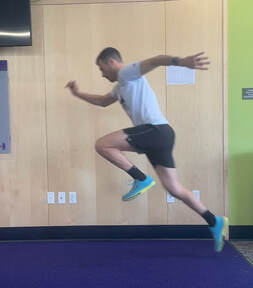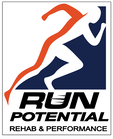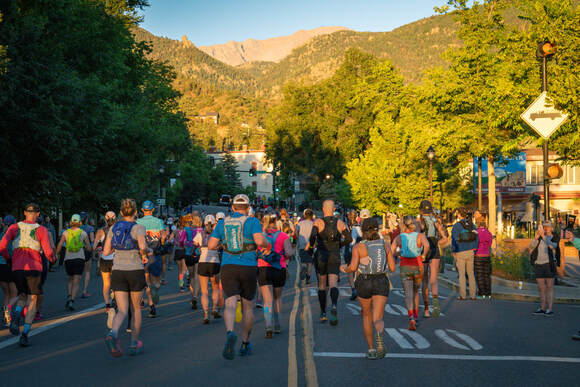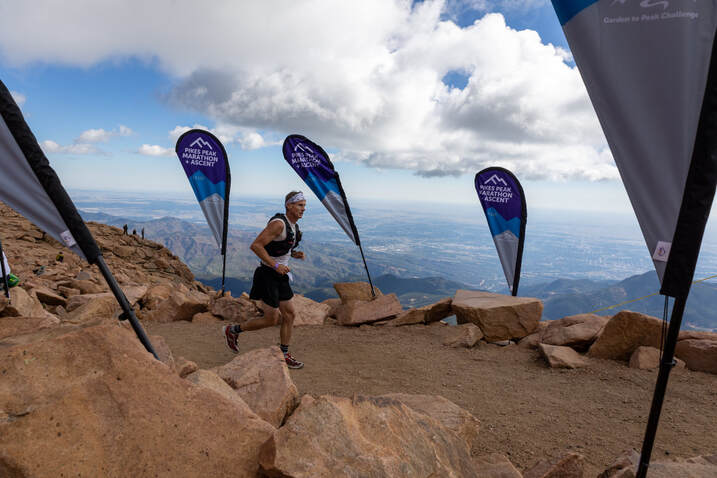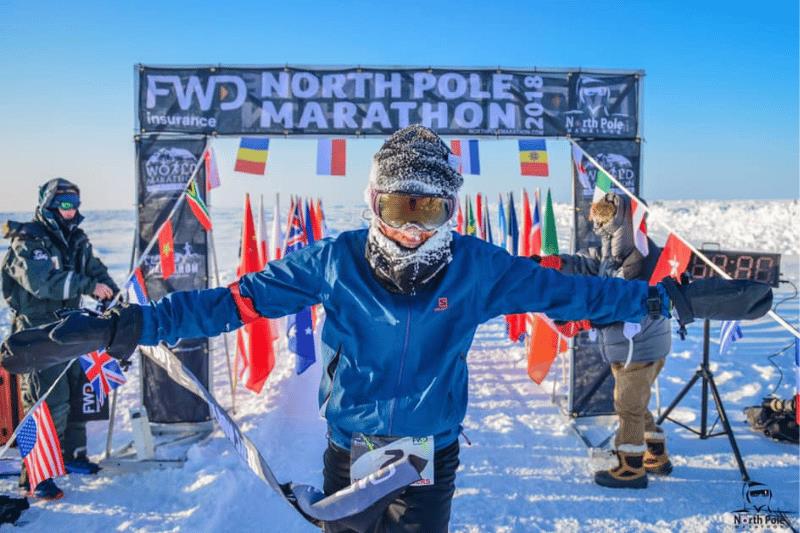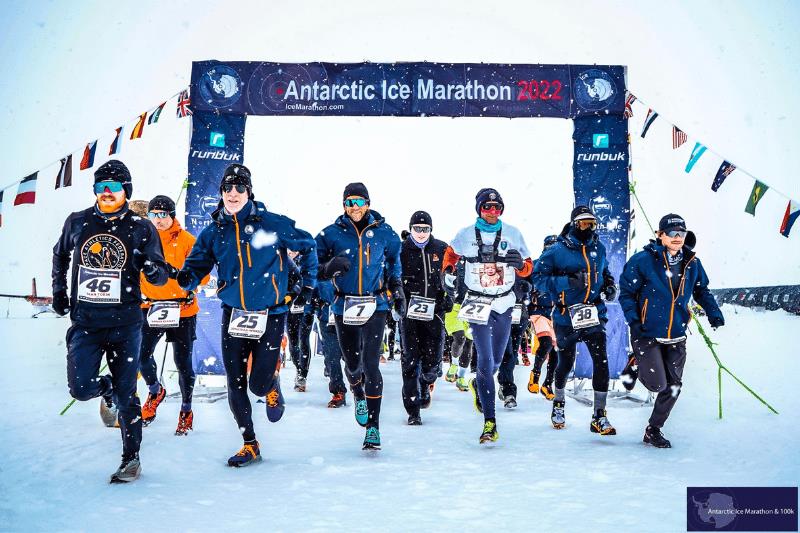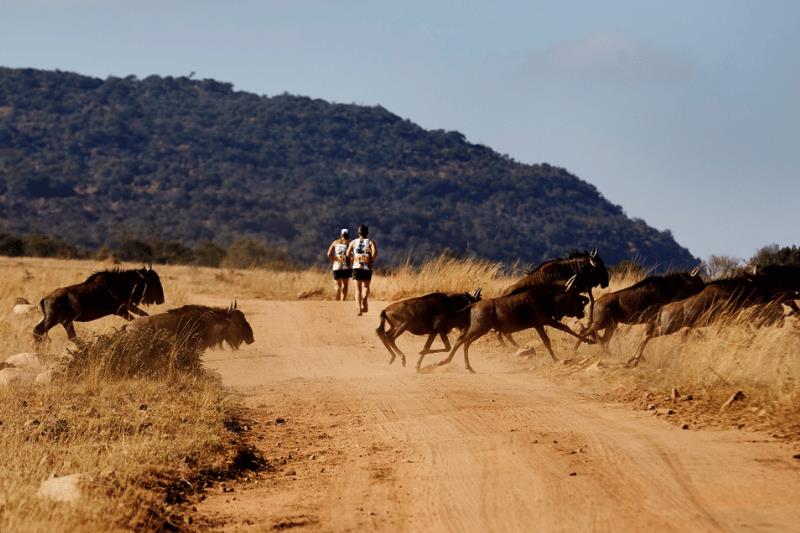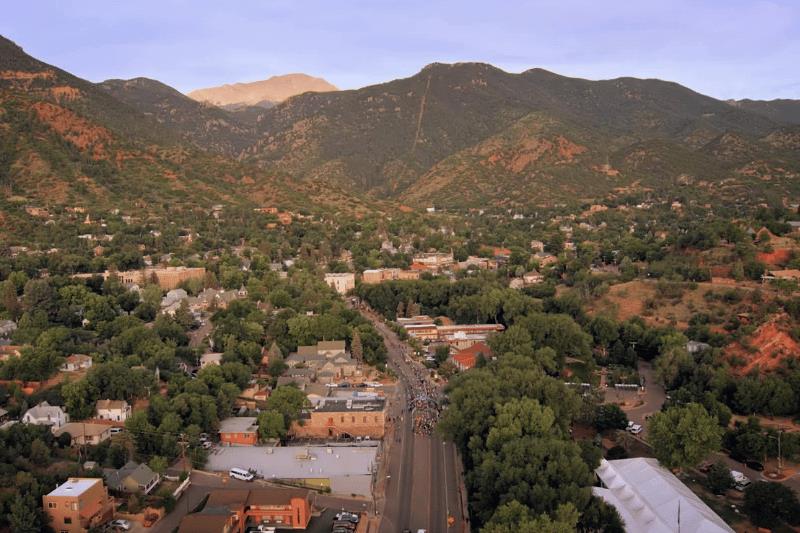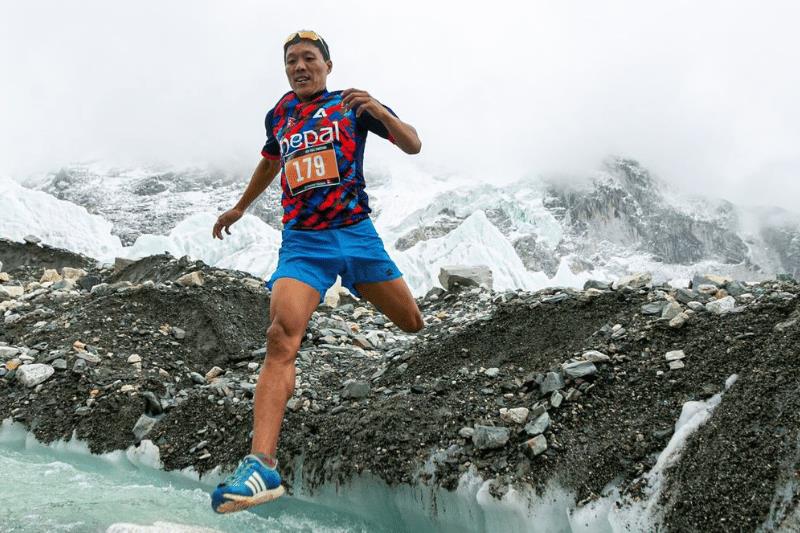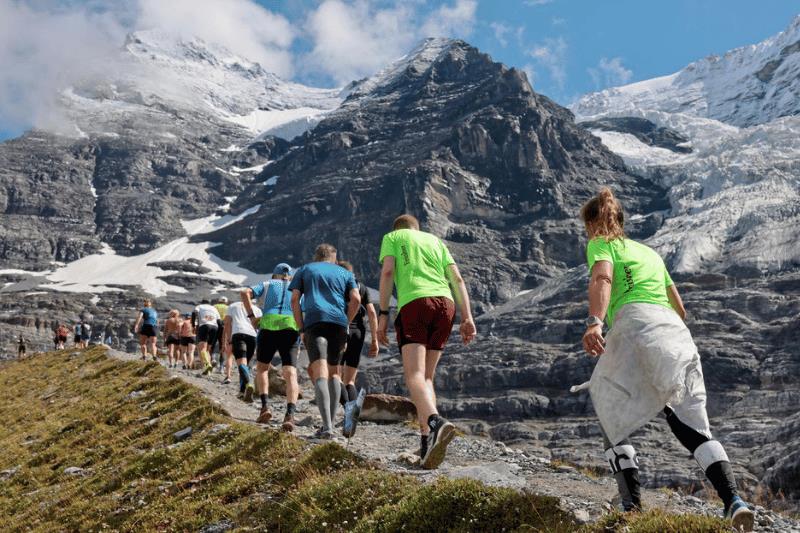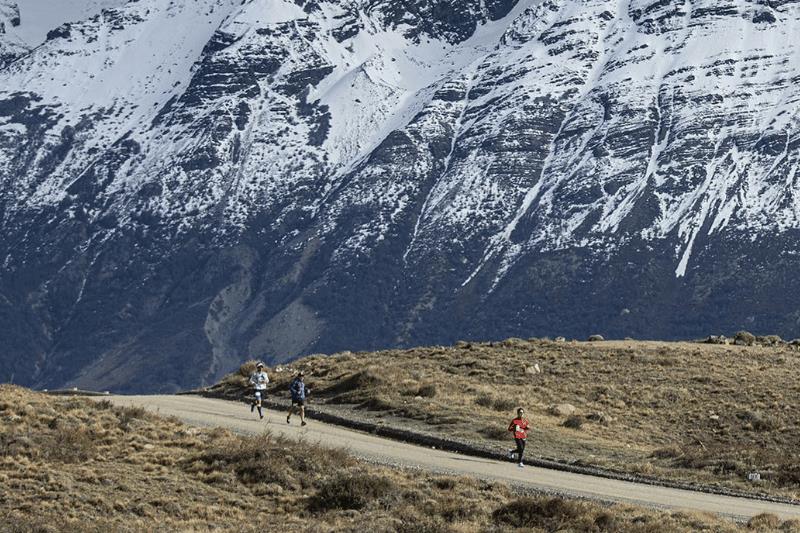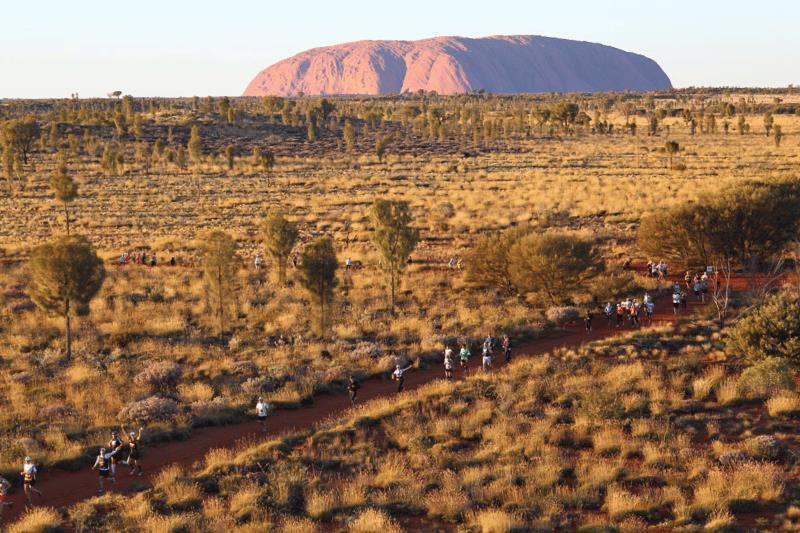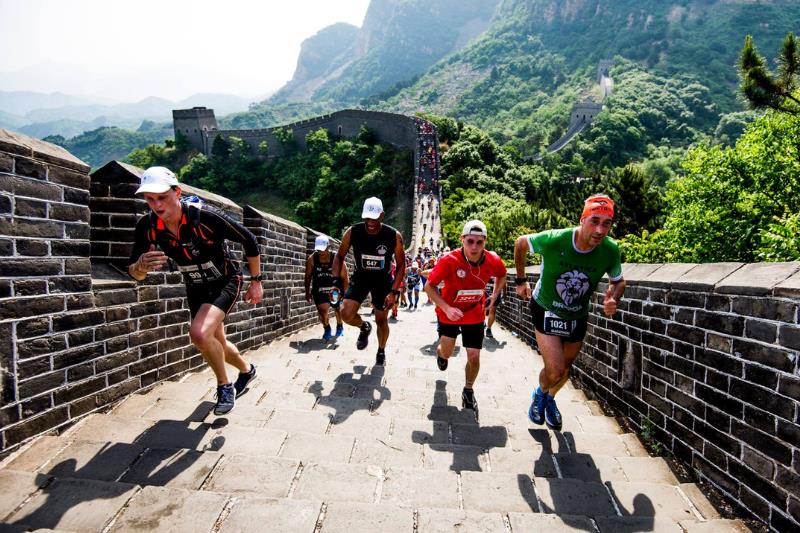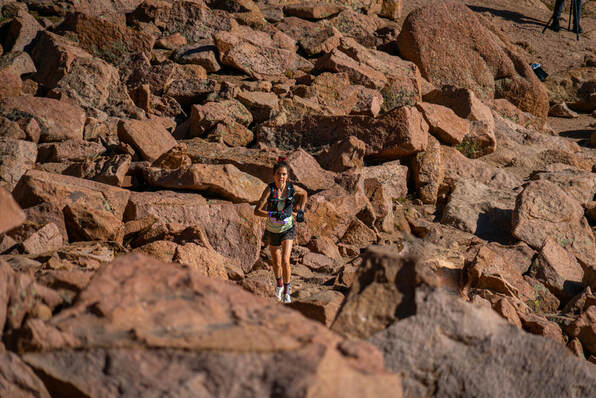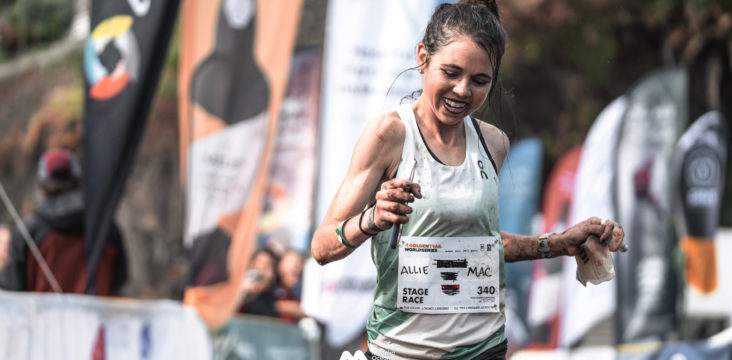Allen Lim, PhDSponsor Post - Article provided by Pikes Peak Marathon partner, Skratch Labs 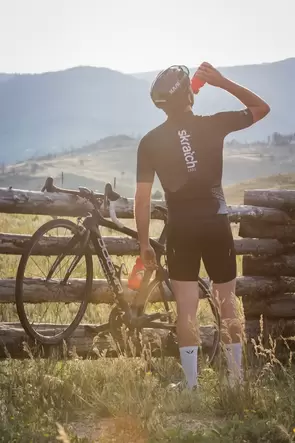 One thing to realize is that in the heat a high sweat rate can easily amount to a 2 liters of fluid loss per hour. Know that at even a 2-3% drop in body weight due to dehydration, our performance can suffer and that by the time we reach a 5% loss, many people can be in a bad place. If you want to learn more on hydration science basics check this out. One of the easiest ways to get at your sweat rate is to use a scale to weigh yourself before and after a workout. Any weight loss (where 1 lb is equal to 16 oz of water) plus the amount of fluid consumed while working out is your total sweat loss. That said, if you're gaining weight over the course of a workout, then you are drinking too much. Ideally, try not to lose more than 3% of your body weight from dehydration. An important consideration, however, is that rehydration during exercise isn't just about water balance, it's also about sodium balance. What this means is that to adequately hydrate, you need to replace both the water and the sodium that you lose during exercise. Unfortunately, sweat sodium is highly individual and can vary anywhere from 400 mg to 2000 mg per liter of sweat, with an average somewhere between 700-900 mg per liter (Skratch Sport Hydration is 800 mg per liter). As a general rule of thumb, if you're not consuming enough salt relative to water, you'll find yourself needing to urinate frequently despite losing body weight due to sweat loss. On the other hand, if you're consuming too much salt relative to water, you'll find yourself wanting to drink more water and potentially gaining weight as the high salt intake might drive you to drink at a greater rate than your sweat loss. Remember, hydration is about 2 needs:
So ... drink to thirst with Sport Hydration Mix while you are working out or racing and if you are underweight after your workout/race add more salt. This could be preloading with our Wellness Hydration Drink Mix or Hyper Hydration Drink Mix, or it could be testing using 1.5 scoops of Skratch per 16 ounces instead. It's generally not the dehydration, in and of itself, that is as much of a problem as the change or increase in body temperature that comes with it. Even if you were properly hydrated, if you get too hot for too long, the heat strain in and of itself can create the symptoms of headache and woe that you experienced. In fact, when I was the sport science director at Garmin and Radio Shack one of our most important priorities immediately after a race in the heat was to bring down core temperature as quickly as possible. We used a combination of cold showers, ice bath dunks, slushies, and cooling vests to do so. What we learned was that as long as body temperature stayed elevated post exercise, the athletes remained in a catabolic state making it impossible to recover or sleep. Another trick we used with the pros for hot training days was to have them head out with knee high panty hose and a rubber band in their back pocket. When it got really hot, they would stop in a gas station and fill the panty hose with ice and close them off with the rubber band. They'd then wrap the ice-filled sock around their necks or just put it down the back of their jersey to help them stay cool on very hot days. We use these same ice socks during hot races and they are often a critical performance factor. Finally, know that at high sweat rates, people tend to lose more sodium in their sweat. In these situations, it may not be enough to just drink a single serving of Hyper before hot training days. Many athletes we work with find that up to a liter of Hyper before is more effective for them. In addition, many will drink a full serving of Hyper in the middle of their ride for their longer (4-5 hours) rides to help replace their sodium loss. Long story short, if you're going to go out in the heat, just know that preparing yourself for the conditions may just take a lot more fluid, salt, and cooling tricks than cooler days, especially if it's humid out and sweating becomes a less effective means of cooling. In addition, after you get done, the first thing to try and do is weigh yourself, drink to the loss, satiate any craving for salt, and cool yourself quickly. Skratch LabsSponsor Post - Article provided by Pikes Peak Marathon partner, Skratch Labs 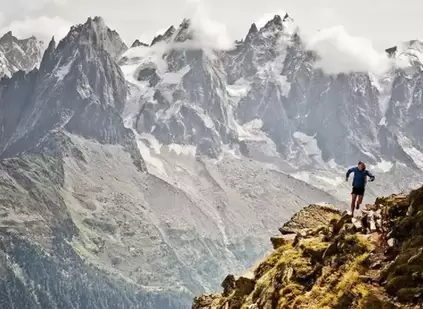 Have you ever ran a marathon when it was supposed to be 'cool' outside but it ended up being super hot? Ever 'carboloaded' the NIGHT before the race and got stomach cramps? Thought you knew what you needed on the day of but ended up stopping in the porta potty at mile 5? Don't worry, we've also made these mistakes before. But we learned. We learned how to fix our mistakes and prep for a better, stronger marathon. These 4 tips are more like tasks. They'll take time, and they're not so simple. Some of them will take longer than others and some of them will be tougher than others. But they worked for us. Check 'em out and give 'em a try.  Photo: Kristin Teig Photography Photo: Kristin Teig Photography Tip 1: Carboload (the right way) Increase the amount of carbohydrates you consume 5-10 days before the marathon, especially after your workouts. Not only will this help top off the carbohydrate or glycogen stored in muscle (which is the critical fuel for the marathon), glycogen also holds a significant amount of water, which helps to increase your total body water. 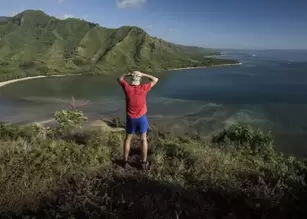 Photo: Michael Garrison @runwithgarrison Photo: Michael Garrison @runwithgarrison Tip 2: Adapt to the heat Make sure that you’re adapted to the heat. It may or may not be hot when you run that marathon but if you’re not ready for the heat, then even the best hydration strategy may not help you cope with hot conditions. Being ready for the heat also causes more water to be stored in your body which will help you even if it’s not hot. To heat adapt, plan at least a third of your training in the heat for at least 6 weeks before your event, making sure that your last session in the heat is within 2 days of your event. If you live in a cool environment, you can do training sessions indoors with more clothing, or heat acclimatize in a hot sauna. As always, listen to your body, your coach, and use common sense. 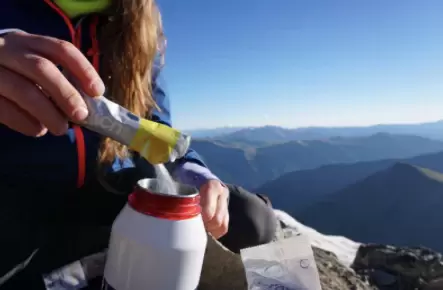 Photo: Brendan Davis Photo: Brendan Davis Tip 3: Dial-up your salt & water intake Pre-hydrate by increasing the amount of salt and water you intake in the days leading up to the marathon. While a high sodium diet isn’t normally recommended for the general public, athletes can lose an appreciable amount of salt through sweat. Moreover, salt is important in driving thirst and in helping us to hold onto water. This is a bad thing if you are hypertensive, but a good thing if you want to be optimally hydrated for a hot marathon. A drink like our Wellness Hydration Mix, formulated to treat severe dehydration, is a great way to pre-hydrate before an event. For extreme heat, many elite athletes use a serving of our Hyper Hydration Drink Mix the night before and the morning of their event. 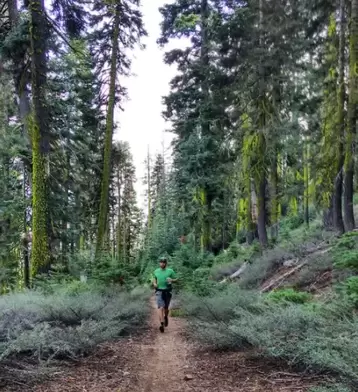 Photo: Naomi Plasterer @naomiplasterer Photo: Naomi Plasterer @naomiplasterer Tip 4: Plan ahead Make sure you’ve got a plan for the day - that you have what you want to drink on course (ideally, a solution that replaces both the water and sodium you lose in your sweat), that you listen to your thirst, that you listen to your body, and that you have the flexibility and common sense to adapt to changing circumstances. Sean Rimmer, Physical Therapist & Running Coach at Run Potential Rehab & Performance in Colorado Springs, CO “Regain your confidence to run pain free & to your potential” 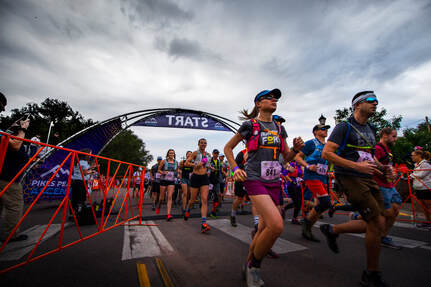 It’s finally June and The Pikes Peak Marathon & Ascent weekend is now about 3 months out. It may appear like there’s plenty of time before race day, but trust me, race weekend will be here in no time! If you’ve read part 1 of this series titled, Start Training, then hopefully you’re in a good position to build on your training this summer; as the training will now progress to build volume and increase in specificity for the demands of the mountain. In part 1 of the training series, we discussed what an early base building strategy could look like which included the following:
Periodize Your Training If you’ve incorporated a plan similar to what was discussed in part 1, then you'll be in good shape to progress this summer; as we will now aim to incorporate periodization to our training. To explain periodized training simply, this process includes cycles of training stress followed by relative training recovery, to allow our body’s to positively adapt over the training process. As I previously mentioned in part 1, as important as your fitness is for the challenge of Pikes Peak, you also must remain healthy. A periodized approach enhances our ability to recover from the stresses of training with an aim to remain healthy during the training cycle. Here’s an example of a periodized cycle of training:
I recommend choosing a 3 or 4 week periodization cycle, where a 3 week cycle would include 2 weeks of training build and 1 week of relative recovery, and a 4 week cycle would look like the aforementioned bulleted points. Training Focus Moving forward, we want to continue to build on our aerobic endurance, our steady state and tempo based efforts, as well as the musculoskeletal strength/capacity to handle the stress of the mountain and our training. If you can train within these domains while increasing the specificity of training towards race week, you will be in a good position to challenge yourself against the mountain come September! Before we jump into any specifics of the training, let’s provide some detail to the training focus terminology. Our aerobic endurance efforts will include the majority of our training with a rating of perceived exertion (RPE) of 5-6/10. This RPE range should correlate to an intensity where you can speak 3-4 comfortable sentences before needing to take a breath. These runs can typically range in duration from 30 minutes to hours. If we keep 70-80% of our training in the aerobic zone, it will enhance our ability to increase the volume of training while also promoting a level of recovery. Keeping a majority of the training at a lower intensity will allow a higher quality effort during our steady state and tempo based runs. Steady state efforts are just a step up in RPE at 6-7/10, where you are still in your aerobic zone, but slightly more challenged. During the talk test, you can speak a few short sentences. These run durations range from 30 minutes to 2-3 hours as continuous or with a short recovery period between bouts, ie. 2-10 minutes. This will be the “bread & butter” effort we will build on, as you will likely be in this effort zone for a majority of Pikes Peak if you are giving a solid effort. Lastly, the tempo run will be the highest effort based run we add to our training which is run just below or at your lactate threshold. Tempo runs are run at an effort between a 7-8/10 RPE, where you can state about a full sentence during the talk test. This effort is hard to say the least. Typically tempo runs range from 10 minutes to 1 hour, with a 2:1 work to rest ratio. If you push yourself on race day, you will likely utilize your tempo based effort during portions of the race, especially ascending above tree-line. What I recommend moving forward is the following base runs which can be periodized based on the total volume and intensity each week within a cycle (~3-4 weeks). This could look like the following:
This turns out to be 4-6 runs per week and 1-2 strength sessions per week. I recommend at least 1 day off of training per week and a minimum of 4 days per week dedicated to your training. 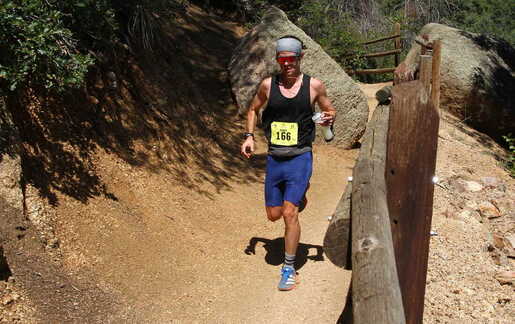 Long Runs The long run will focus on time rather than mileage due to the nature of the mountain course. I recommend keeping these runs in the aerobic endurance effort until August, by then we can add in some quality within or long run to become more specific for the event (ie. steady state efforts within the long run). In general, focus on keeping your long runs to <50% of your total weekly running volume, but more specifically, your long run does not need to be longer than your estimated race time for the ascent and up to 75% of your marathon time. So for example, if you expect to run the ascent in 4 hours, then your long run does not need to be longer than that in duration. If your marathon time is expected to be 7 hours, then your long run can be up to ~5 hours. It’s more about the build up of long runs over the next few months rather than any particular singular long run. Your long run should incorporate some practice hiking (unless you are an elite) as you will likely not be running the entirety of either race. Here are some key points for your long run:
Steady State Runs The steady state run will be the staple workout as you build over the summer. This is typically 1-4 longer based efforts that are moderately hard, but sustainable. For example, this could look like the following:
The early phase includes 20 minutes at intensity and 50 minutes in duration total, and the late phase includes 90 minutes of intensity and 130 minutes of total duration. This is just an example, as progressions should be varied based on the individual. However, the ultimate goal is to increase time at intensity even if it’s broken up by short recovery jogs/walks, as this will allow us to perform more intensity within a given quality run. As the steady state runs become longer in total duration, they can be incorporated into your long run. Tempo Runs The tempo runs will be incorporated more so initially this summer, but will begin to phase out come August with a focus more on steady state efforts. The goal of the tempo run is to build on some relative speed and our body’s ability to shuttle lactate to become more efficient at our highest aerobic intensity. These workouts will allow us to feel a bit more uncomfortably comfortable during our steady state runs. An example of an early and late phase tempo run workout could look like the following:
The early phase includes 24 minutes at intensity and 62 minutes in duration total, and the late phase includes 45 minutes of intensity and 89 minutes of total duration. Again, progressions may vary based on the individual, and these runs can also incorporate hiking if it fits within your intensity based RPE. Strength/Plyometric Training I did touch upon strength and plyometric training in part 1, but just to recap, this type of training sprinkled in will aid in tissue health (ie. bone, tendon, muscle, etc.) by increasing tissue capacity at varying loads, tissue length(s), and speed of movement. Initially, this type of training can be added into your training plan 1-2x a week, however, in the later stages of July and August, you can reduce this type of training to 1x per week. This will be due to the increase in running volume and intensity ~1 to 1.5 months out from race day. I still recommend only working a few heavier movements, and some plyometrics to enhance your muscle-tendon stretch shortening cycle. Similar to part 1, I recommend the following heavy load based movements:
Performing 1-2 sets (including 2 warm up sets) of 5-8 reps for each movement at a moderate to heavy load should suffice to hit the areas that are loaded during running. I recommend reducing the amount of sets as you progress throughout the training process to reduce soreness. The plyometric movements incorporate jump/hop based exercises focused on short ground contact time. This improves our ability to store energy and release it at a faster rate which can lead to efficiency as we run. These exercises can also focus on agility, as there is some technicality to Pikes Peak which includes some rock hopping! Some of the plyometric exercises I recommend are as follows:
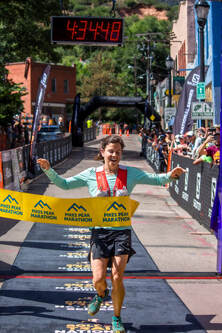 Both of these exercise variations focus on dynamic balance, reducing ground contact time, and agility to potentially enhance your ability to navigate some trail technicality. You can be more creative with the plyometrics, but simple is also effective. I recommend adding these prior to your heavier lifts to reduce excess fatigue. I recommend incorporating your strength/plyometric days as far away from your tempo/steady state runs to not compromise the quality of those runs. This could potentially mean doing a quality run in the morning and a strength session that evening if possible. Aerobic Endurance Runs The aerobic endurance runs will be added into your training program between intensity based runs, and can range from 30-90 minutes of an easy flat recovery, to hiking from 30-90 minutes, to a hike/run combo of 30-90 minutes. The general concept for these days is keeping intensity rather low (can vary from a run to hike depending on the terrain), with duration ranging from 30-90 minutes. You should feel fairly good by the end of these training sessions, if you don’t, question what your true intensity was during a given session. 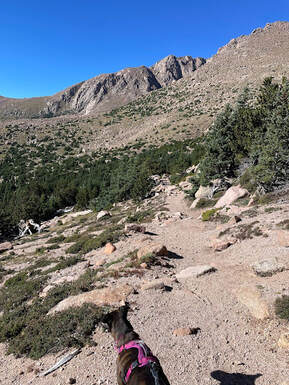 Barr Trail at Tree-Line Barr Trail at Tree-Line Putting the Pieces Together Now that we have an understanding of the variable training sessions we can implement during the week, let’s highlight everything together. Just to review, I’m not providing a specific training plan as everyone’s training background and ability to train is vastly different; however, the aim of this section is to give guidance on how to put your own training cycle together. Here are the key points to consider when building your training cycles.
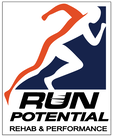 Hopefully, this article provides you with a road map on how to get from point A to point B, with you finding your path based on your specific needs. The path may not be direct and may include detours, but it’s all about ultimately making it to your destination aka. Pikes Peak with some confidence and fitness build in. *If you need more guidance or accountability for your training, I recommend finding a running coach sooner than later to work on a specific training plan for you. Stay tuned for Part 3 come August. The focus will be on fine tuning and tapering for race week! Written by: Sean Rimmer, Physical Therapist & Running Coach at Run Potential Rehab & Performance in Colorado Springs, CO. “ Regain your confidence to run pain free & to your potential” Spencer McKeeSpencer McKee is OutThere Colorado's Director of Content and Operations. In his spare time, Spencer loves to hike, rock climb, and trail run. He's on a mission to summit all 58 of Colorado's fourteeners and has already climbed more than half. 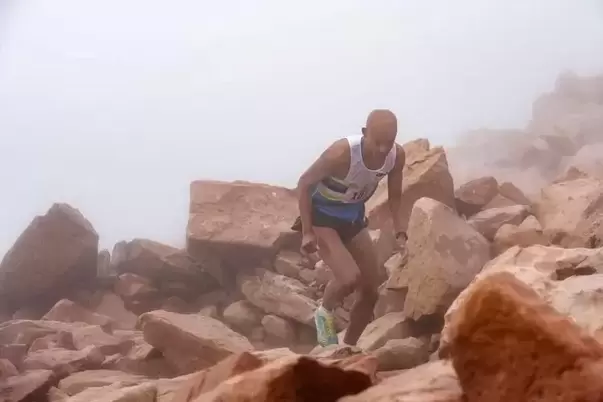 Joseph Gray, 37, from Colorado Springs, nears the finish at the summit of Pikes Peak during the Pikes Peak Ascent on Saturday, Aug. 21, 2021. Gray took first place with a time of 2 hours, 12 minutes and 7 seconds. The 13.3-mile Pikes Peak Ascent begins in front of the City Hall in Manitou Springs and continues up Barr Trail with an elevation gain of 7,800 feet to the summit of America's Mountain at 14,115 feet. Racers were challenged by the 30 degree weather, high winds and poor visibility once above tree line and to the summit. (The Gazette, Chancey Bush) Joseph Gray, 37, from Colorado Springs, nears the finish at the summit of Pikes Peak during the Pikes Peak Ascent on Saturday, Aug. 21, 2021. Gray took first place with a time of 2 hours, 12 minutes and 7 seconds. The 13.3-mile Pikes Peak Ascent begins in front of the City Hall in Manitou Springs and continues up Barr Trail with an elevation gain of 7,800 feet to the summit of America's Mountain at 14,115 feet. Racers were challenged by the 30 degree weather, high winds and poor visibility once above tree line and to the summit. (The Gazette, Chancey Bush) A publication that's all about running, RaceRaves, recently published the results of their readers' poll regarding the best marathon in each American state. After the votes were tallied, a race that's among the most difficult marathons in the world ended up on top. A September race that involves 26.2 miles of mountain running, 7,815 feet of vertical gain, and reaching a wild elevation of 14,115 feet above sea level, the Pikes Peak Marathon was dubbed the best marathon in the state. The trail climbs to the summit of 'America's Mountain,' passing a wide variety of terrain along the way including steep forest running, more climbing on alpine trails, and a rocky mid-point with exposure to the elements and a lack of oxygen. Not only does a race of this nature require extreme endurance and the ability to exert oneself at elevation, it also means having a durable body that can handle a brutal descent on an uneven surface and tired legs. Perhaps even more impressive, some runners opt to compete in a half marathon dubbed the Pikes Peak Ascent on the day before the full marathon run, aiming to became a 'doubler.' This shorter race follows the same trail, but only involves the uphill portion. It's no surprise that this race was also honored as the 'best half marathon' in the Centennial State. The runner-up 'best marathon' was the Denver Colfax Marathon, which is typically held in May each year. The runner-up 'best half marathon' was the REVEL of the Rockies race, which is known for being a fast race as it's mostly downhill. This year, the Pikes Peak Marathon and Ascent weekend will take place from September 16 to 17. Marathon registration is $225 and Ascent registration is $200. Find full lists of the country's best marathons by state here. Best half marathons can be found here. Sean Rimmer, Physical Therapist & Running Coach at Run Potential Rehab & Performance in Colorado Springs, CO“Regain your confidence to run pain free & to your potential” 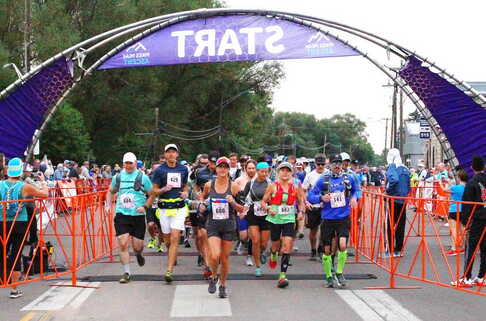 Photo Credit - Skip Williams Photo Credit - Skip Williams So you’ve signed up for the Pikes Peak Marathon or Ascent, now what? Well the simple answer would be to start some sort of training as Pikes Peak will demand a lot from you, both mentally and physically. Whether you’ve signed up for the Marathon or Ascent you will need to overcome a challenging course with an overall elevation gain of 7,815' (2,382m) from start to summit, an average grade of 11%, and high altitude conditions ranging from 6,300' (1,920m) at the start and 14,115' (4,302m) at the summit. If you’re only doing the Ascent, congratulations! You just need to overcome the grind up Barr trail from Manitou Springs to the summit. But, if you're one of the lucky ones who signed up for the Marathon, you will need to endure the descent from the summit back into Manitou Springs in one piece. In this 3-part training prep series, I will highlight early, mid-stage, and late-stage training for Pikes Peak Marathon and Ascent. Now, as a disclaimer, everyone’s background in training history is different and there are a multitude of other variables that can affect how and when you train. This training series will highlight training principles, not a specific training plan, that can be modified based on your baseline fitness, goals, health, and lifestyle. 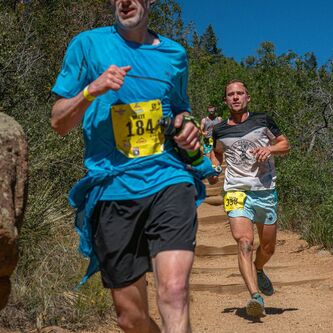 Photo Credit - Peter Maksimow Photo Credit - Peter Maksimow Early Training: 5-Months until Race Day Early focus in your training should highlight building musculoskeletal strength, base aerobic endurance, and the least specific running based workouts of short duration at a high intensity. The ultimate goal of early training is to prepare your body for more training in the mid- and late-stages of Pikes Peak preparation. It’s important to have the opportunity to build on your training by avoiding “burnout” and remaining healthy (as this is never a guarantee), so you can progress your training over the next 5 months. You will need excitement to be present on the starting line if you want a chance to perform at your best on race day. In the early stages of training April-May, a recommended program could look like the following:
This is a safe and conservative place to start for the average recreational runner that will likely be accommodating to someone of working class with a family. At this stage of training, 3-5 hours of total training is likely adequate and sustainable for the average person. As I previously mentioned, your run training should be focused on building an aerobic base as well as shorter duration/higher intensity intervals (least specific to race day). Depending on where your fitness level is at, I recommend the following 3 types of runs per week:
The focus for the easy effort runs will be on low intensity activity to build your aerobic system which you will need to be efficient come race day. When you run, try to keep your heart rate (HR) at 75-80% of HR max. For example, if your HR max is 190 bpm, then you would likely keep your HR from 140-150 bpm during your run or brisk walk/run combo. However, because HR data can be skewed on wearable devices, I recommend using a conversational pace to gauge intensity where you can speak several sentences before requiring a breath. Keep your ego aside for this low intensity training, as you may need to walk intermittently during your runs if your perceived effort or HR gets too high, especially if you're on rolling or hilly terrain. This relatively lower intensity training will build the foundation to improve our body’s ability to utilize oxygen within our muscles and tissues while running, improve recovery between sessions, may reduce musculoskeletal tissue stress, and allow you to increase your training volume over time. These types of runs will help raise your floor or base fitness, but the running intervals will help raise your fitness ceiling. The interval run workouts are of short duration but rather intense. For the “on” portion of the intervals, you should be pushing yourself rather hard while focusing on speed and/or power output. If you are breathing hard where you can only get a few words out, you are doing this workout correctly. If you are using a HR to gauge intensity, this workout will often increase your HR to 95% of HR max if done correctly. I typically recommend these workouts on an uphill grade ranging 3-10% to reduce the risk of musculoskeletal injury while also increasing power output. Due to the intensity of interval runs, I recommend an equal “off”portion or recovery time to the run. That may mean a slow jog back down the hill or an easy walk to recover before the next “on” portion. Since PPM/A is rarely flat, beginning to implement uphill workouts as a training stimulus will be helpful as the training progresses. Strength or resistance training has been a controversial topic within the running community for some time now. But, there is value in not just building strength of your muscles, but to build capacity within your musculoskeletal tissues (ie. bones, tendons, ligaments, etc) through loaded movements. Strength or resistance training has also been shown in the literature to improve running economy; which describes how efficient we are as runners at utilizing the least amount of energy at a given pace. And lastly, as a physical therapist who works with runners, by improving our tissues capacity to handle heavy loads and variable speed of loading, our body often remains healthier as our training becomes more demanding. Early on in your PPM/A training, strength or resistance training 2x a week for 20-30 minute sessions should be all you need. I typically recommend strength or resistance training sessions to be on the same day (later in day) to a running interval workout or the following day. This allows for a potential reduction in soreness or fatigue on your running workout day. As your running volume progresses over the next few months, strength or resistance training will turn to more of a maintenance plan of 1-2x per week with less total reps and less eccentric loading to reduce soreness/fatigue. The two types of exercises I recommend to start training consist of the following:
Now, there are a multitude of resistance based exercises you could perform, but variations of these 3 exercises can get the job done for heavy and slow resistance movements:
These exercises hit all of the major muscle units while providing external load to further improve connective tissue capacity in your lower body. I typically recommend a warm up set for each for 10 reps, and 2-3 working sets. The first set at a moderate-heavy weight for 6-8 reps, and the final 2 sets at a heavy weight for 3-5 reps. The last 1-2 sets should be challenging, where you could often only get about 3 more reps. The plyometric exercises consist of body weight movements focused on the stretch-shortening cycle of your muscle-tendon units. These exercises are jumping or hopping based movements, focused on short ground contact time. Typically you only need a few sets of these exercises to get the job done, as you are already training plyometrics when you run. Here’s what I recommend:
For the double or single leg hops for power in place, I recommend 2 sets of 10-12 reps. The focus should be on relative stiffness in your hips, knees, and ankles to reduce ground contact time while producing power to increase your flight time. For the double or single leg reactive hops moving forward, you are basically doing the same thing but with some horizontal movement by hopping forward. I recommend 2 sets of 6-8 reps for the forward hops. This can be performed by taking a small hop forward, then taking your reactive and powerful hop forward from the initial hop. Then re-set for the next rep. I recommend training the plyometrics in the beginning of your strength session to be fresh prior to the heavy lifting, or you can train plyometrics on the same day as one of your easy runs. With any good training program, your training and fitness should progress over time. This guide provides a starting point with some practical tools that may work well if you are new to training. For the next 1-2 months, I recommend building your training off these initial guidelines by increasing the duration of any run, adding another run per week, or increasing the volume of intensity with a given running workout. I do not recommend altering volume, duration, or intensity together in any single week of training to reduce the risk of training error or injury. When it comes down to it, be smart, listen to your body, and enjoy the process of this training. Pikes Peak will be waiting for you come September. Stay tuned for Part 2 coming in June 2023. Original Publication by USA Today 10Besthttps://www.10best.com/awards/travel/best-marathon-2023/
Article Courtesy of USA Today10Best
4/7/2023 The United States hosts around 1,000 marathons every year, the largest of which see tens of thousands of endurance runners crossing the finish line and conquering the grueling 26.2-mile distance. To find the top races, 10Best editors and a panel of experts made their nominations, then readers voted for their favorites. Here are the 10 best marathons across the nation for 2023. No. 10: Boston Marathon - Boston, Massachusetts The Boston Marathon is one of the oldest and most prestigious marathon races in the world, first run in 1897. Taking place annually on Patriots' Day in April, the race begins in the town of Hopkinton and finishes near Copley Square. The Boston Marathon is known for its challenging course and enthusiastic crowds, attracting elite runners from around the world as well as thousands of amateur runners of all ages and abilities. No. 9: New York City Marathon - New York City, New York Known for its enthusiastic crowd support, the famous New York City Marathon embodies the spirit and energy of the city where it takes place. A celebration of diversity and inclusivity, runners from all over the world come together to participate in this iconic event. The course takes runners through all five boroughs of the city, starting in Staten Island and finishing in Central Park. Along the way, runners pass by many of the city's famous landmarks, including the Verrazzano-Narrows Bridge, the Empire State Building and Times Square. No. 8: Walt Disney World Marathon - Walt Disney World Resort - Orlando, Florida Attracting around 20,000 participants, the Walt Disney World Marathon is one of the most popular annual marathons in the country. Runners experience the magical atmosphere of Disney World as the course winds through all four of its theme parks. Participants also encounter a variety of Disney characters and entertainment acts throughout the race. No. 7: Hatfield McCoy Marathon - Williamson, West Virginia The longest-running marathon in the states of Kentucky and West Virginia is the popular Hatfield McCoy Marathon, which traverses both states on its journey. Named after the infamous Hatfield-McCoy feud, the challenging course takes runners through the rugged and beautiful Appalachian Mountains and includes both road and trail sections. No. 6: Big Sur International Marathon - Big Sur, California Famed for its stunning views of the Pacific Ocean, rugged coastline and picturesque scenery, the Big Sur International Marathon is a favorite among runners and nature lovers alike. In addition to breathtaking vistas, this challenging course features significant elevation changes on its route from Big Sur, north along Highway 1, to the finish line in Carmel. The USATF-certified course has been called “one of the jewels of American running.” No. 5: Humpy's Marathon - Anchorage, Alaska Humpy's Marathon in Anchorage is part of the city's annual Runfest events. Expert Amy Bushatz says, "This road race in Alaska's largest city is known for its enthusiastic course support and free grilled cheese sandwiches at the finish line." Named after a popular local bar and restaurant, the challenging course takes runners through the scenic streets of downtown Anchorage, with views of the Chugach Mountains. No. 4: Bank of America Chicago Marathon - Chicago, Illinois One of the six World Marathon Majors, the Bank of America Chicago Marathon is typically held on the second Sunday in October. The flat, fast course takes runners past iconic Chicago landmarks on its journey through 29 neighborhoods, starting and finishing in Grant Park. This popular race attracts more than a million spectators and to participate, runners must apply through the race's lottery system or run for a charity team. No. 3: Shiprock Marathon - Shiprock, New Mexico Held the first weekend of May, the Shiprock Marathon takes runners through the rugged desert landscapes of the Navajo Nation. Along the way, participants enjoy a variety of live music to motivate runners, adding to this unique and memorable running experience. No. 2: Marine Corps Marathon - Washington, D.C. Known as "The People's Marathon," the Marine Corps Marathon honors the dedication and sacrifice of the United States Armed Forces. The race is known for its rich history and is one of the largest marathons in the world. With a course that winds through the streets of Arlington, Virginia and Washington, D.C., the route passes many of the area's famous landmarks and monuments, including the National Mall and the U.S. Capitol. No. 1: Pikes Peak Marathon - Manitou Springs, Colorado The Pikes Peak Marathon is considered one of the most challenging marathons in the world, with runners ascending and descending the 14,115-foot summit of Pikes Peak. In addition to the grade, the altitude can prove difficult for many runners. Despite the challenges, runners are rewarded with breathtaking views (literally) of the Rocky Mountains and the surrounding wilderness. Original publication by RaceID12.20.22 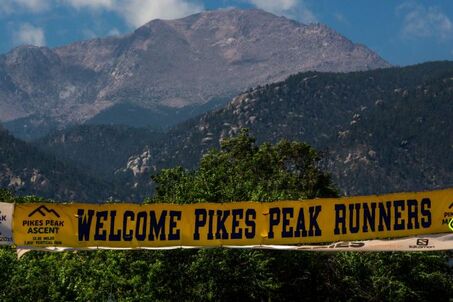 The Pikes Peak Marathon is one tough race. The 7,815' vertical climb complete with rocks, roots, turns, and steep grades followed by the grueling downhill return to the base has been appropriately termed "America's Ultimate Challenge". In 2022, there were 864 registered runners representing 42 states and 10 countries. Runners came from around the world to test their physical and mental abilities against the 14,115' Pikes Peak. But how do the unique challenges of Pikes Peak relate to other marathons around the world? The team at RaceID set out to find out just that. What are the most extreme marathons in the world? It turns out, Pikes Peak ranks #4 in their top 10. RaceIDs 10 of the Most Extreme Marathons in the World 26.2 miles or 42.195km is a classic distance and the official length of a marathon. There are many epic and extreme races around the world, but not all can be classified as marathons in the traditional sense. We therefore went on a search for the most extreme marathons over the classic distance in the world. Situated on all continents the marathons we found are very different and offer a wide variety of challenges for participants. Ranging from steep and continuous ascents to battling ice cold or even wild animals one thing is for sure and that is that participants will never forget the experience of doing one of these ten races. 1. The North Pole Marathon, North Pole With extreme sub-zero temperatures the Geographical North Pole offers one of the worlds, if not the most extreme marathons on the planet. Labeled “The World’s Coolest Marathon” participants who finish will become members of a very exclusive club of a few hundreds of people in the whole world. The race takes participants over snow and arctic ice flows with the course situated near and around the Geographical North Pole. More info: https://www.npmarathon.com Image courtesy to: North Pole Marathon 2. The Antarctic Ice Marathon, Antarctica The south pole may offer one of the most unique and incredible endurance race experiences in the world. With a quite hefty price tag of $19,500 USD participants enter a very exclusive club of runners who can say that they have done the Southernmost Marathon on Earth. More info: https://www.icemarathon.com Image courtesy to: Antarctic Ice Marathon 3. The Big 5 Marathon, South Africa Running a marathon in the habitat of some of the world’s most spectacular (and dangerous) animals must be considered unique and extreme. The Big 5 Marathon does just that where you run next to Elephants, Rhinos, Buffalos, Lions and Leopards. There are no fences, rivers or barriers that separates the runners of the marathon from the wildlife living in the habitat. More info: https://big-five-marathon.com Image courtesy to: Albatros Adventure Marathons 4. Pikes Peak Marathon, USA Starting at Manitou Springs, the Pikes Peak Marathon takes you on a 7815 foot (2382m) vertical climb all the way up to Pikes Peak summit at 14115 ft (4300m) and back down. This is a marathon like no other as it takes you on a wide variety of trails averaging an elevation of 11% grade. Participants will truly be challenged physically as well as mentally due to the course's challenging nature. The race is run in September each year and selected as part of the Golden Trail Series 2022. More info: https://www.pikespeakmarathon.org Image courtesy to: Pikes Peak Marathon 5. Everest Marathon, Nepal The world’s highest marathon gives you a challenge like no other! The marathon starts at the Everest Base Camp and takes you 42.195km to Namche Bazar with a course mainly downhill. The terrain itself is a real challenge as it goes mainly on trekking trails taking participants down from a whopping +5000m to just below 3500m. The race takes place in May each year. More info: https://everestmarathon.com Image courtesy to: Everest Marathon 6. Jungfrau Marathon, Switzerland Self-claimed as the “most beautiful marathon in the world”, the Jungfrau Marathon in the Swiss Alps will be sure to give you a tough adventure beside its spectacular scenery. With a climb of 1953 meters you are sure to be given a serious challenge before reaching the finish line at 2320 meters altitude. More info: https://www.jungfrau-marathon.ch/en/ Image courtesy to: Jungfrau Marathon 7. Baikal Ice Marathon, Russia Siberia offers one of the most extreme races on the planet. Approximately 65 kilometers from Itkursk you find the beautiful lake of Balkai where one of the The Baikal Ice Marathon is a running race over 42.195k solely on ice. Not only are participants challenged by the vast plains of iced surface, but participants must also master the cold. More info: https://www.absolute-siberia.com/en/pages/ice_marathon.html Image courtesy to: Baikal Ice Marathon 8. Patagonian International Marathon, Chile In Torres del Paine National Park participants from all over the world gather in September each year to experience the Patagonian International Marathon. The course takes participants through the national park that is situated at the 51° south latitude with an elevation difference of approx. 1000 meters. Running in Patagonia means harsh conditions but also a completely unique experience in epically sculptured surroundings over 70 million years in formation. More info: https://www.patagonianinternationalmarathon.com/en/ Image courtesy to: Patagonian International Marathon 9. Australian Outback Marathon, Australia The Australian Outback invites everyone that truly wants to get off the beaten track. With the majestic Ayers Rock as backdrop the full marathon takes you from Uluru to Kata Tjuta. The course is relatively flat, but the challenge lies in mastering a great variety of terrain, such as outback roads, sand dunes and trails. More info: https://australianoutbackmarathon.com Image courtesy to: Australian Outback Marathon 10. The Great Wall Marathon, China Each year, along one of mankind’s greatest structures, the Great Wall Marathon takes place in May. With an ascent of 5164 steps, participants are sure to be given a real challenge on the cobbled surface of The Wall’s pathway. More info: https://great-wall-marathon.com/ Image courtesy to: Albatros Adventure Marathons Jeff Darman - Road Race Management, Inc.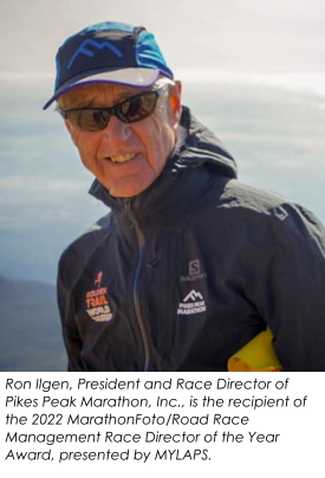 A committee made up of race directors, athletes, media, corporate executives and club officials has named Ron Ilgen, Pikes Peak Marathon, Inc. President and Race Director, as the MarathonFoto/Road Race Management Race Director of the Year. MYLAPS is the presenting sponsor. He will be honored at a reception at the Road Race Management Race Directors’ Meeting in Hollywood, FL on December 8. Phil Stewart, Editor and Publisher of Road Race Management, said: “We’ve honored 35 individuals with the Road Race Management Race Director of the Year award since 1987, and they have faced plenty of challenges, but none have been quite as daunting as organizing a marathon and half marathon up one of Colorado’s tallest peaks. Thin air is only a minor inconvenience – but can be challenging, as I know from experience when I crawled into an aid station above the 12,000-foot level when I completed the race – but nature throws plenty of other challenges on the Front Range of the Rockies, including blizzards, forest fires and flash floods, to which our nominee has had to respond. He has done so for the last 20 years, which has earned Ron Ilgen the 2022 MarathonFoto/Road Race Management Race Director of the Year Award presented by MyLaps.” Ron’s nominator said of him: “Ron Ilgen has been the lifeblood of the Pikes Peak Marathon, Inc. race for over 25 years. Ron began his involvement with the Pikes Peak Ascent and Marathon as a volunteer, a lead volunteer and eventually the executive director and overall race director. Ron has provided oversight and direction for all races under the organization’s brand for the past 20 years. “Race directing a trail race up a 14,115-foot mountain is more of a mountaineering event than a traditional running race. The logistics and volunteer needs are extensive to pull off successful back-to-back races. Ron has navigated some of the worst circumstances a Race Director can imagine keeping the Pikes Peak Marathon going strong. In 2005, the race experienced a massive storm that left hundreds of runners trapped on the summit of Pikes Peak. In 2006, a blizzard caught 1,000 runners off guard, and they had to finish in trash bags to protect themselves from the elements. In 2012, Colorado Springs was devastated by the Waldo Canyon Fire that led to a flash flood and significant damage to the Manitou Springs area during race week. In 2018, Ron made the tough call as Race Director to cut the Ascent race short due to the weather forecast. Finally, as all Race Directors experienced, COVID-19 threw a curveball in 2020, but Ron pushed ahead and challenged his team to navigate the COVID-19 guidelines and still host the Marathon event, making Pikes Peak Marathon now the longest recurring marathon in the U.S. (67 years running in 2022). “Ron is fueled by the history of the Pikes Peak races, so much so that he dedicated several years to finding the first woman to finish the Pikes Peak Marathon in 1959, Arlene Pieper. For 50 years Arlene Pieper did not know she made athletic history as the first woman to ever compete a sanctioned marathon in the U.S., until 2000 when the stars aligned, and Arlene was located and invited to be part of the 50th running of the Pikes Peak Marathon. “The fiercely loyal volunteer base is derived from a deep respect and appreciation for Ron’s leadership. He extends appreciation for all volunteer positions and engages in the race prep work on the mountain. Ron himself has completed each volunteer duty in his many years with the race organization, and volunteers appreciate that aspect of his leadership.” The MarathonFoto/Road Race Management Race Director of the Year award (presented by MYLAPS) is made annually to recognize and promote excellence in race directing. Nominees were judged on several factors, including overall ability, reputation of race, creativity and organizational ability. For a list of previous recipients, visit https://www.rrm.com/act/rdm/rdypast.asp. Road Race Management (www.rrm.com) is a member-based organization that publishes a digital newsletter and many other publications designed for race and industry professionals and conducts a prestigious annual national race directors’ meeting and trade show in Florida. MarathonFoto (www.marathonfoto.com) combines the industry’s best logistics and customer service, all supported by cutting-edge technology, to create images and videos to celebrate and inspire athletes. MYLAPS (https://www.mylaps.com) helps athletes, timers and events to create the ultimate sports experience for participants, followers and sponsors. Announcement from the Golden Trail Series presented by Salomon Running - 30th October 2022, Start 9:00 AM, 30.5 KM, 1,555M V+ FUNCHAL, MADEIRA, PORTUGAL Rémi Bonnet and Allie McLaughlin finish the year in style by winning the last stage in the GTWS 2022 Grand Final! 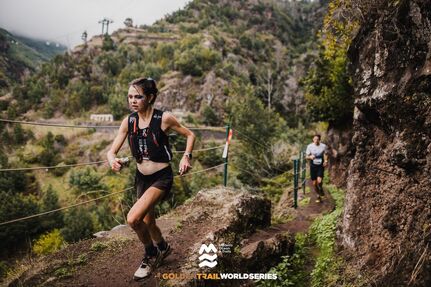 Photo credit: @joaomfaria Photo credit: @joaomfaria Happy birthday Allie! She turned 32 today! And what better way to celebrate it! Allie McLaughlin (Team On Running, USA) took victory on the Golden Trail World Series’ last stage. "I wore fancy dress today," she said at the finish line. "it was really cool to hear the supporters at the top saying 'oh look it’s Harley Quinn!' I’m really thankful to be a part of the Golden running community. We’re on an incredible island, everyone loves running, we share the same passion, what better birthday present could I wish for! It’s true, I set off at a ‘fun pace' – some would say a hard pace – I was with a group of guys in the climb, but I couldn’t keep up with them. I felt great, even if I think I pushed it a bit too hard, especially as there was still a way to go in the downhill. I was told that Nienke couldn’t catch me now, but I didn’t believe it so gave it all I had till the finish line!" Just behind her was the Golden Trail World Series 2022 winner: Nienke Brinkman (Team Nike Trail, The Netherlands). "I’m wrecked," she said at the finish line. "I’m really pleased with this week; I gave everything I had and now I need a break! But I really wanted to do all the stages, even though I had already won the GTWS with yesterday’s result. I also wanted to thank my parents and my family who came here and were so much support on this race, it was amazing!" Julie Roux (Team Salomon, France) completes the day’s podium, she has been gaining momentum throughout the week. "I felt pretty good today. I wanted to play this stage’s Sprint segment and here I caught up with Bailey. So I suddenly felt euphoric and told myself I was going to really go for it right up to the finish. I’m thrilled with this result and my entire week!" Check out all the Grand Final – Madeira Ocean&Trails® ranking here: (rankings for each stage: – ELITE – OPEN – Overall Ranking – Segments – GTNS) https://goldentrail.stopandgo.pro Check out the Golden Trail World Series 2022 overall ranking here: https://goldentrailseries.com/series/gtws.htm Announcement from the Golden Trail Series presented by Salomon Running | October 26th, 2022, Start 9:00 am, 24.5km, 1,540 meters V+ | Seixal, Madeira, Portugal. 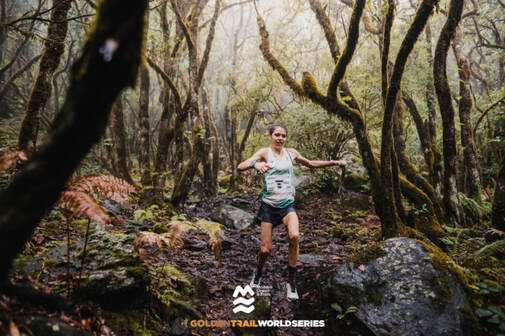 Photo credit: @joaomfaria Photo credit: @joaomfaria 26th October 2022, Start 9:00 AM, 24.5KM, 1,540M V+ SEIXAL, MADEIRA, PORTUGAL Rémi Bonnet and Allie McLaughlin win the first of the five stages of the Madeira Ocean&Trails® Stage Race, the Golden Trail Series Grand Final. The October rain lashed the peaks of Madeira Island. The conditions were rough for the start of the first stage of the Golden Trail Series Grand Final, which is probably the most technical stage out of the five stages in store for the runners this week. Today’s programme had a steep climb taking the runners up to 1,400 metres above sea level before attacking the downhill, which was just as steep, and strewn with a mish-mash of slippery wet stones, rocks, roots, and steps. Rémi Bonnet on top form! We knew this stage’s profile would suit Rémi Bonnet (Team Salomon, Switzerland), who certainly forged a gap on the climb before keeping his pursuers at bay on the treacherous downhill. Only Elhousine Elazzaoui (Team Pini Mountain Racing, Morocco) was able to follow the Swiss on the first part of the race course, both beating their pursuers by almost 5 minutes at the finish. In the end, the final victory was raced between these two in the downhill, and it was Rémi Bonnet who pipped the post in first place. "I felt really good today," he confided at the finish line. "I played for the climbing segment but without putting myself too much over the limit. Once the segment was over, I kept in control by lowering my heart rate. Only Elhousine kept up with me, I was afraid he’d catch me on the runnable parts because he goes very fast. But when I heard him catching up in the downhill, I gave it some gas and it worked. I was surprised at how well I did on the downhill, it’s the first time I’ve had such a good pace. I was feeling fit today, I can’t wait for the next stages!" Elhousine Elazzaoui was very happy with his second place. "The downhill isn’t my strong point," he explained. "Rémi is very strong, he did a great job! I wasn’t far from winning my first race of the Golden but there’s still four more stages to go, so we’ll see!" Petro Mamu (Team Scarpa, Eretria) completes the ELITE men’s podium, and he’s not used to these kind of racing conditions. "I’m really pleased with this third position! It was hard today with very technical sections, but I didn’t do too badly. Here, the terrain is varied with difficult conditions, especially because I had a problem with my foot, but it seems ok now. There are four more races, I need to rest and try and do as well, but I’m happy with my third place!" Note that Manuel Merillas (Team Scarpa, Spain) was disqualified from the today’s stage for not respecting the race rules, having left his poles at the top of the climb. Allie McLaughlin, a successful landing! Her plane had barely touched down from her final flight, Allie McLauglin (Team On Running, USA) took three days to reach Madeira, due to flight cancellations and delays. She arrived at 2 am at the hotel, without her luggage, and yet she was at the start line the same morning beaming from ear to ear. She crossed the finish line in first place 2h30min later with the same smile. "I hadn’t felt this good since Mount Marathon! You would’ve thought that the trip would’ve drained me but in fact I managed to rest well between each flight and was philosophical about it. I fell into a huge puddle, and I thought I’d killed my phone. I saw Nienke behind me just before the downhill and even though my legs were jello I love the downhill, so I said this is where I have to pull away or she’s gonna catch me! I don’t think I will do all the stages, but no doubt this evening when I see the ranking, I may change my mind, we’ll see." Nienke Brinkman (Team Nike Trail, The Netherlands) took her first loss this season. "I’m very satisfied with this second place! I ran conservatively in the downhill, I broke my wrist recently when I fell, and I didn’t want to break a second one. I knew I wouldn’t be able to catch Allie anyway, I just hoped no one else would catch me! I feel good and pretty fresh for the next round, I just wanted to be careful today. The weather conditions were pretty harsh and cold, it was very slippery, but I really want to make the most of this race and the island. I’m just happy to have succeeded and not destroyed my body today!" Élise Poncet (Team Sidas X Matryx, France) came in third place after a ferocious downhill. "I’ve just joined the land of the mutants! In trail running there are mutants like Nienke, Maude, Allie, and Sophia, and then there’s humans like us! But today I proved to myself that I too can be at their level. But to do that I had to take massive risks in the downhill. I’m really proud of myself and this result, but I think it’ll force me to rest on the next stage. I’ll see how I recover but I don’t want put my health in danger and I can feel that I burned a lot of energy and my muscles and joints have taken a beating." The best from the OPEN category In the OPEN category it was Manuel Innerhofer (Austria) for the men and Malen Osa (Spain) for the women who came out on top. "It was tough, and the weather was harsh, but I prefer that than when it’s hot," confided Manuel Innerhofer at the finish line. "I feel pretty good and I’m looking forward to the next stage." Satisfied with her race Malen Osa is now wondering about the rest of the week. "I felt really good. In the climb I was feeling really great, but I didn’t want to push too hard in the downhill because I’ve never done a stage race like this before and I’m not sure how I will recover. I hope to feel like I did today." The DACH in the lead Beyond the individual rankings the Golden Trail National Series runners compete for a team ranking, with the times of the top two men and top two women from each team combined for the ranking. So, vying for this title today the GTNS ALL/AUT/CHE was the strongest, just 2 minutes ahead of GTNS ITALY and the GTNS FRA complete the podium already 20 minutes behind. Results ELITES – STAGE 1 Men 1 – RÉMI BONNET (CHE – SALOMON/RED BULL): 02:04:41 (+100 pts) 2 – ELHOUSINE ELAZZAOUI (MAR – PINA MOUNTAIN RACING): 02:05:18 (+88 pts) 3 – PETRO MAMU (ERI – SCARPA): 02:11:44 (+78 pts) 4 – THIBAUT BARONIAN (FRA – SALOMON): 02:12:07 (+72 pts) 5 – ROBERT PKEMBOI (KEN – SKY RUNNERS KENYA) 02:12:14 (+68 pts) Women 1 – ALLIE MACLAUGHLIN (USA – ON RUNNING): 02:30:25 (+100 pts) 2 – NIENKE BRINKMAN (NLD – NIKE TRAIL): 02:33:20 (+ 88 pts) 3 – ELISE PONCET (FRA – SIDAS X MATRYX): 02:34:37 (+ 78 pts) 4 – SOPHIA LAUKLI (USA – SALOMON): 02:35:50 (+72 pts) 5 – CAITLIN FIELDER (NZL – SALOMON): 02:40:44 (+68 pts) GTNS TEAM 1 – GTNS GER/AUT/CH: 10:20:07 2 – GTNS ITALY: 10:22:46 3 – GTNS FRA: 10:49:49 4 – GTNS ESP/POR: 11:08:58 5 – GTNS MEXICO: 11:10:06 Check out all the Grand Final – Madeira Ocean&Trails ranking here: (rankings for each stage: – ELITE – OPEN – Overall Ranking – Segments – GTNS) https://goldentrail.stopandgo.pro Check out the Golden Trail World Series 2022 overall ranking here: https://goldentrailseries.com/series/gtws.htm |
©
Pikes Peak Marathon

